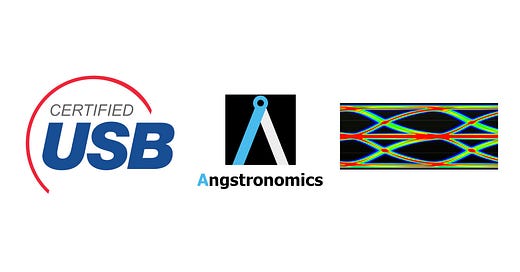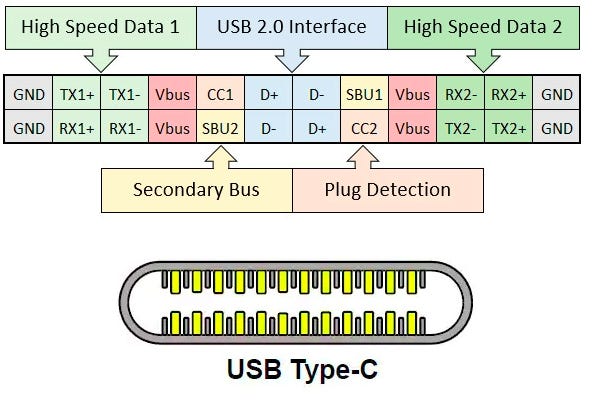The USB Promoter Group has just announced the new USB4 Version 2.0 specification, touting up to 80 Gbps data rates from the same Type-C connectors. While the major headline is the doubling of speeds over USB4, Angstronomics has dug up a neat feature about the new standard that enables additional functionality.
Keysight Documentation Details PAM3
6 months ago, Angstronomics discovered documentation of Keysight Technologies M8040A Bit Error Ratio Tester that listed input testing support for “USB4v2“.
In April, Keysight published an article in Chinese about their S94USBCB USB Type-C® Interconnects Compliance Test Software, that stated “support for doubling the Tx/Rx speeds in future USB implementations (for example the next generation USB standard USB4V2.0)”.
Also in April, Keysight released their PathWave Advanced Design System (ADS) 2022 Update 2.0 Software, where their website lists USB4v2 (PAM3) AMI Model Builder, and their W3081E PathWave USB AMI Modeler page “Builds USB4V2 AMI models for Tx and Rx“, “for USB with next generation PAM3 modulation“.
Thus, we can see that USB4 v2 achieves 80 Gbps through PAM3 physical layer architecture. This lines up with the deleted tweet by Gregory M. Bryant, former head of Intel’s Client Computing Group, that showed a poster with “USB 80G“ PHY based on PAM-3 modulation.
Special Trick: USB4 v2 is also 120 Gbps*
Standardized in 2014, the USB Type-C connector has 2 pairs of high speed data links, each with a transmit and receive. Thus, in a normal USB data configuration the 4 lanes are configured in a 2 Tx + 2 Rx symmetric setup. For USB4 v2 that does 40 Gbps per lane, that means 80 Gbps bi-directional bandwidth.
However, USB4 v2 also enables an asymmetric 3 Tx + 1 Rx configuration, meaning 120 Gbps out from the host and 40 Gbps back from device to host. This asymmetric setup then allows tunneling of the full DisplayPort UHBR20 rate that takes 80 Gbps of bandwidth out to a monitor while simultaneously supporting 40 Gbps bi-directional USB data transfer rates on top of that. This would meet the requirements of a single cable monitor + docking station solution that could handle 8K144 HDR with Display Stream Compression and no chroma subsampling with an integrated 40 Gbps USB hub at full bandwidth with no contention.
*Of course this asymmetric setup is not new to the USB standard. We already have examples of USB-C docks and monitor hubs that can do 4K60 + 10 Gbps USB3 concurrently on the same USB3 cable, with 2 lanes of DP 1.4 HBR3 out for 4K60 and the remaining 2 lanes for 1 Tx + 1 Rx enabling 10Gbps USB speeds. Thunderbolt 3, USB4 and USB4 v2 flexibly adjusts transmit and receive bandwidth as all data types are muxed and demuxed at each end of the cable.
When is it coming?
The deleted tweet was posted over a year ago, so we know Intel has been working on this for awhile. Hence, we expect them to be among the first to bring USB4 v2 capable host processors to market. As Intel’s future Meteor Lake and Arrow Lake CPUs share the same connectivity and IO capability and will not be succeeded into 2025, we believe it will bring USB4 v2 in late 2023 and into 2024 when Meteor Lake launches.
As for AMD, which has lagged behind in integration, they have to wait for industry partners to develop off-the-shelf design libraries before they can be integrated into their processors. We saw that with USB4, where Ryzen 6000 (Rembrandt) arrived ~1.5 years after Intel 11th Gen Core-U (Tiger Lake). And we should see that again with USB4 v2, as AMD’s 2024 “Strix Point“ processors do not integrate USB4 v2.
It is also a reasonable assumption that M-series Apple Silicon will integrate USB4 v2 in a similar timeframe between Intel and AMD.
Of course, having host support is not useful if there are no devices that take advantage of it. So we expect the external SSD, monitor and hub ecosystem to start building into 2024 and beyond.
Overall, we are excited that USB-C is finally doubling bandwidth. It will have taken the industry over 8 years to go from 40 Gbps Thunderbolt 3 in 2015 to 80 Gbps USB4 v2 in 2023+. However, we have concerns of cost and adoption over the need for active or even tethered cables for such high bandwidth over meaningful distances.
Update: Our assumption that Meteor Lake and its successor will integrate USB4 v2 is incorrect. USB4 v2 will be enabled through external Barlow Ridge controllers.







How does this relate to Thunderbolt? What about the excessive processor overhead that has plagued USB vs. other I/O technologies?
It's frustrating how deceptive the marketing can be with these specifications, but I believe it's going to be 80 Gb/s of unidirectional bandwidth not bidirectional? That's due to 20 Gb/s per differential pair of which there are four. This would be a doubling over the 10 Gb/s per diff pair that thunderbolt 4 and USB 4 currently do.